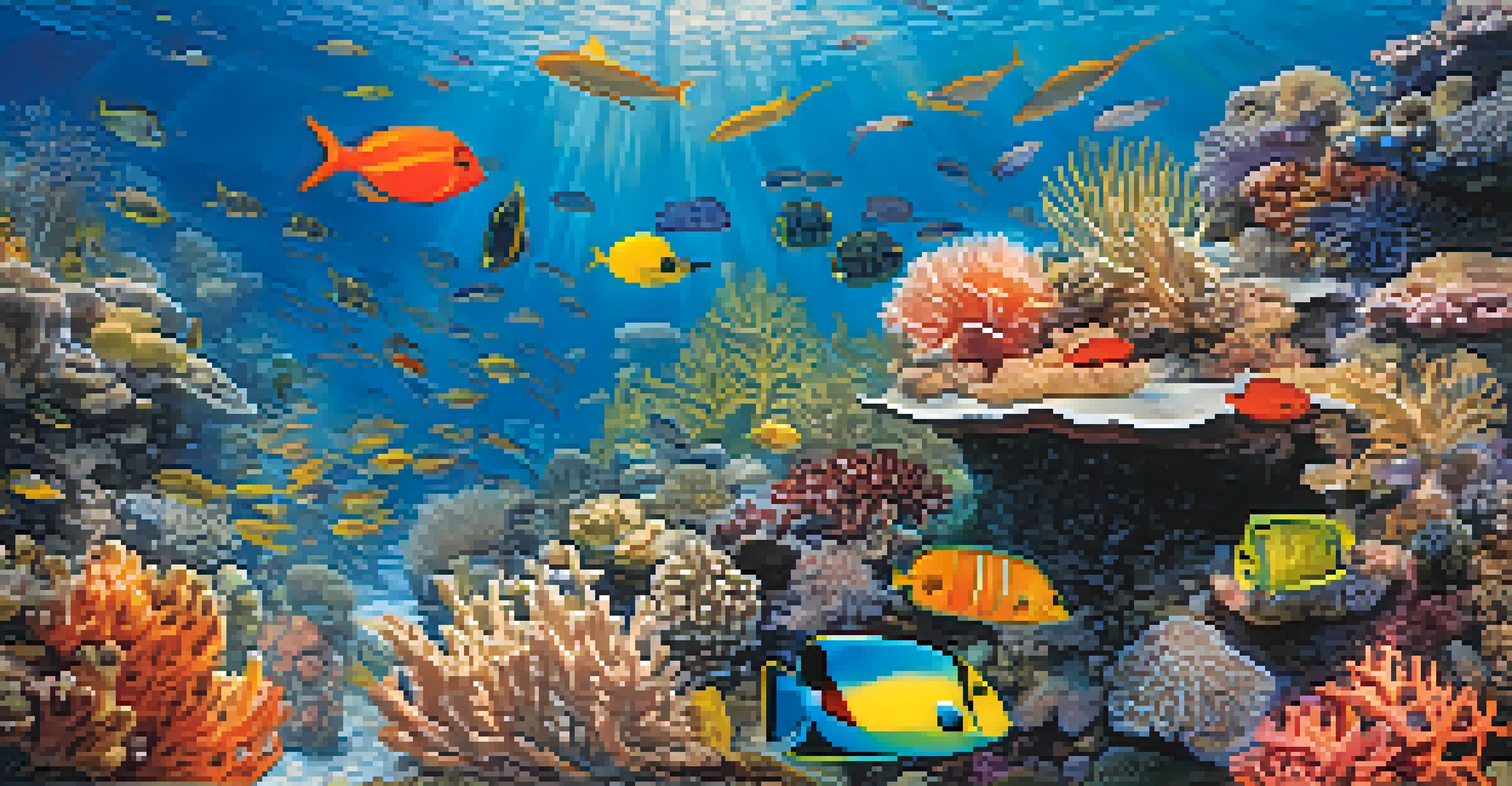Climate Change Effects on Hawaii's Geography and Biodiversity

Rising Sea Levels Threaten Hawaii's Coastal Regions
Hawaii's beautiful coastlines are at risk due to rising sea levels, a direct consequence of climate change. As glaciers melt and ocean temperatures rise, coastal erosion becomes a growing concern. This not only threatens homes and infrastructure but also the unique ecosystems that thrive along these shores.
The greatest threat to our planet is the belief that someone else will save it.
Coral reefs, which provide habitat for countless marine species, are particularly vulnerable. Increased water temperatures lead to coral bleaching, weakening their structures and affecting biodiversity. A decline in coral health impacts not just fish populations but also the livelihoods of local communities dependent on fishing and tourism.
Additionally, saltwater intrusion into freshwater aquifers is another consequence of rising seas. This intrusion can compromise drinking water supplies and agricultural irrigation, posing a significant threat to food security in the region.
Changing Weather Patterns Affect Hawaii's Climate
Climate change has led to more erratic weather patterns, altering rainfall distribution across the Hawaiian Islands. Some areas experience heavier rainfall, leading to increased flooding, while others suffer from prolonged droughts. These shifts can disrupt ecosystems, affecting plant and animal life that depend on specific weather conditions.

For instance, native Hawaiian plants, adapted to particular rainfall patterns, may struggle to survive in drier conditions. This can lead to a decline in biodiversity, as these plants are crucial for various species, including birds and insects. The loss of native flora can create a cascade of effects throughout the ecosystem.
Rising Seas Endanger Hawaii's Ecosystems
Climate change-driven rising sea levels threaten coastal communities, coral reefs, and freshwater supplies in Hawaii.
Moreover, the increase in extreme weather events, like hurricanes, poses a further risk. These storms can cause significant damage to landscapes, eroding soil and displacing wildlife, making recovery a challenge for the delicate ecosystems of Hawaii.
Impact of Ocean Acidification on Marine Life
As the oceans absorb more carbon dioxide, ocean acidification becomes a pressing issue for Hawaii's marine ecosystems. This change in ocean chemistry can have detrimental effects on coral reefs, which are vital to the health of marine biodiversity. Lower pH levels hinder corals' ability to build their calcium carbonate structures, leading to weaker reefs.
Climate change is no longer some far-off problem; it is happening here, it is happening now.
The repercussions extend beyond corals; many shellfish species, such as clams and oysters, also struggle to form their shells in more acidic waters. This not only threatens these species but also impacts the larger food web, affecting fish populations that rely on shellfish as a primary food source.
The health of coral reefs and marine life is vital for Hawaii's economy, particularly for tourism and fishing industries. Protecting these ecosystems from acidification is essential for sustaining both the environment and the livelihoods of those who depend on it.
Threats to Endemic Species Due to Habitat Loss
Hawaii is home to a remarkable array of endemic species, plants, and animals found nowhere else on Earth. However, climate change, coupled with human activities, poses a significant threat to these unique species. Habitat loss due to rising temperatures and changing precipitation patterns can lead to population declines.
For example, native birds like the Hawaiian honeycreeper are particularly vulnerable as their habitats shift or shrink. Loss of suitable nesting areas and food sources can lead to decreased populations, pushing these birds closer to extinction. This loss would not only be a tragedy for biodiversity but also for cultural heritage, as these species are integral to Hawaiian identity.
Climate Change Disrupts Agriculture
Unpredictable rainfall and rising temperatures challenge Hawaii's agriculture, impacting crop yields and food security.
Conservation efforts are crucial to mitigate these impacts, such as creating protected areas and restoring native habitats. By prioritizing these actions, we can help preserve Hawaii's unique biodiversity for future generations.
Invasive Species Flourish in Changing Conditions
The changing climate in Hawaii also creates favorable conditions for invasive species to thrive. These non-native plants and animals can outcompete local species for resources, further threatening native biodiversity. As temperatures rise, invasive species may expand their range, putting additional pressure on already endangered species.
For instance, invasive plants like guava can create dense thickets, displacing native flora and altering habitats. This displacement reduces food sources for native wildlife and disrupts the delicate balance of the ecosystem. The spread of invasive species can lead to a loss of biodiversity, making it more challenging for native species to adapt to environmental changes.
Addressing the invasive species issue requires concerted efforts, including monitoring and management programs. By controlling these invaders, we can help protect Hawaii's native ecosystems and the unique species that inhabit them.
Impact of Climate Change on Agriculture in Hawaii
Agriculture in Hawaii faces significant challenges due to climate change, affecting both crop yields and food security. Changes in rainfall patterns can lead to either drought or flooding, making it difficult for farmers to cultivate their crops reliably. This unpredictability can result in reduced harvests, impacting local economies and food systems.
Moreover, rising temperatures can alter growing seasons, forcing farmers to adapt their practices or switch to different crops. For instance, traditional crops like taro may struggle in hotter conditions, jeopardizing cultural practices tied to agriculture. Farmers must find ways to innovate and adapt to ensure their livelihoods while also preserving cultural heritage.
Invasive Species Threaten Native Life
Changing climate conditions enable invasive species to outcompete and displace Hawaii's unique native flora and fauna.
Investing in sustainable farming practices is essential for resilience against climate change. By implementing strategies like agroforestry and water conservation, farmers can better manage their resources and contribute to the overall health of Hawaii's ecosystems.
Community Resilience and Adaptation Strategies
Building community resilience is essential for adapting to the impacts of climate change in Hawaii. Local communities are already implementing strategies to cope with the challenges they face, such as establishing community gardens and promoting sustainable practices. These initiatives not only enhance food security but also foster a sense of community and cultural identity.
Education plays a crucial role in these efforts, as raising awareness about climate change can empower individuals to take action. Workshops and community events can provide valuable information on sustainable practices, helping residents understand their role in protecting their environment. By encouraging active participation, communities can strengthen their resilience against climate impacts.

Collaboration between local governments, organizations, and residents is vital for effective adaptation strategies. By working together, they can develop comprehensive plans that address the unique challenges Hawaii faces, ensuring a more sustainable future for both the environment and the people who call it home.